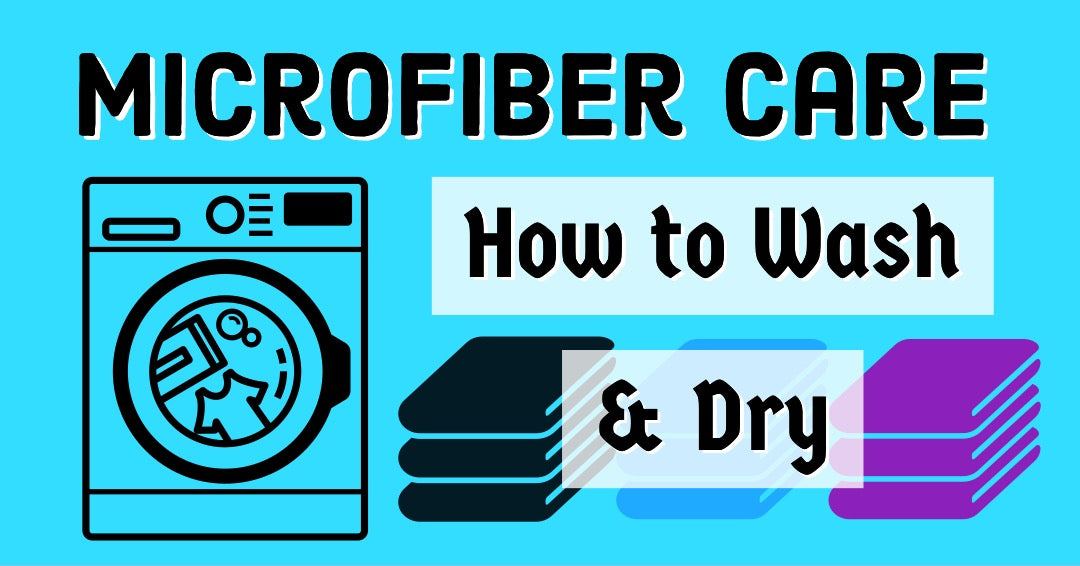
How to Wash Microfiber?
HOW TO WASH MICROFIBER TOWELS IN WASHING MACHINE:
- Wash prior to use: to remove residual lint and dye from the manufacturing process
- Wash separate from cotton products: so foreign lint is not picked up
- Wash light and dark separate: darker colors can bleed, microfiber is not color fast
- Do not use bleach: it can break down the fibers making them fragile & less absorbent
- Machine dry on low heat: high heat can melt the fibers lessening the cleaning ability and making them rough
- Do not use fabric softeners: they leave film and clog the "micro" fibers
- For best results use Micro-Restore 'The Original Microfiber Detergent'; only 2 oz. needed per 5 gallon load Household laundry detergents may not be effective at fully cleaning microfiber, and may leave a residue after washing

Washing microfiber towels prior to their first use is a good idea. This will remove any residual lint, and extra dye from the manufacturing process.
Microfiber cleaning products are machine washable. High quality products, that are cared for correctly will last for hundreds of washings. Wash microfiber towels separate from other types of fabric (like cotton bath towels or clothes) because they can pick up the foreign lint.
As with all polyester fabrics, bleach should be avoided, as it can break down the fibers making them fragile and less absorbent. Some brands advertise beach safe microfiber, but their advertising is stretching the truth a bit. They achieve this “bleach safe” by adding a protective coating to the fibers, which deteriorates over time and makes the products less effective at cleaning and absorbing.
Microfiber cleaning products can be machine dried, but high heat should be avoided since it can melt the fibers lessening their extreme cleaning ability. Most household water heaters and washing machines don’t get hot enough to melt the fibers, so, unless your water heater is set to above 140 F, don’t worry about washing on hot. Hot cleans better.
Where you must worry about heat is the dryer. Even low heat settings can cause the metal drum inside the dryer to become hot. The centrifugal force of the spinning drum can pin a few of the towels to the hot drum for an extended period of time and cause the fibers to melt and become stiff. This can turn your towels into sandpaper and cause scratching.
Microfiber fabric softeners should also be avoided because they leave a film on the surface and can clog the tiny pours of the split micro-fibers.
Microfiber is not color fast (unless they are 100% polyester). Polyamide, the second component in high quality microfiber products, is the absorbent component of the fiber, and it absorbs the dye, just as it absorbs water and other liquids. When you wash microfiber towels, it is inevitable that some of the absorbed dye is released. This means that darker colors should we washed separate from lighter colors.
If you are cleaning extremely dirty surfaces with heavy oils, grease or dust most household laundry detergents will not be effective at cleaning those elements from the microfiber fabric. A stronger laundry detergent is required that can emulsify the heavy oils and grease. Furthermore, many household detergents contain fabric softeners and unnecessary scents. Using more detergent will not make your towels cleaner, in fact they can leave a residue on the fibers that can lessen their cleaning ability. For this reason, we developed Micro Restore – The Original Microfiber Detergent. This microfiber wash detergent is a highly concentrated (only 2 oz. are needed per 5-gallon load) laundry detergent suited for emulsifying heavy grease and oil.
If you accidentally use too much Micro-Restore or must use extra household detergent to clean your microfiber towels (because all you have is weak household detergent), you can add distilled white vinegar to the rinse cycle. The reason this works is because the detergent is alkaline, and the vinegar is acidic. The vinegar in the rinse cycle will neutralize the excess detergent and prevent it from coating the towels and clogging the fibers. DO NOT add the vinegar at the beginning of the wash with the detergent. This will neutralize the cleaning ability of the surfactants in the detergent.
It is normal and unavoidable that lighter colored microfiber towels will slightly stain.
If you are cleaning or polishing a delicate surface that could be easily scratched it is important that you use a clean towel free of debris. In general, high quality microfiber towels do not scratch, but if they contain debris that can scratch it can be a problem. For this reason, it is important to continuously switch to a clean towel surface when wiping. If you drop the towel on the ground it is better to switch to a clean towel that you know is free from debris.



Leave a comment